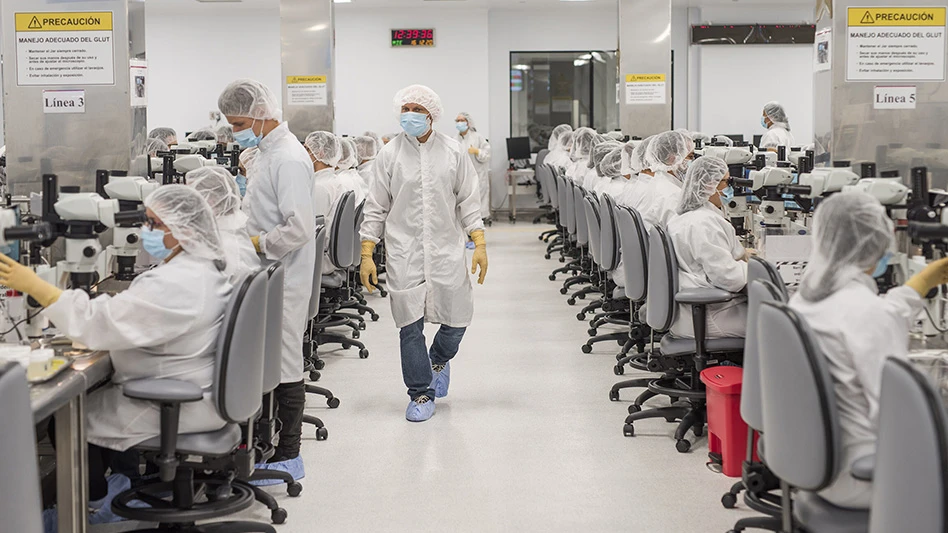
CINDE
Costa Rica has become a strategic hub for medical device manufacturing and exportation. Why?
In 2023, the country's exports were valued at more than $7,500 million, impressive growth representing an average annual increase of 18% from 2017, ranking it as the second largest exporter of medical devices in Latin America and the fifth largest supplier to the United States. Behind this growth are not only the sector's diversification and sophistication but also a strategic vision that has attracted the world's top medical tech firms. At present 14 of this sector's 30 major multinationals have set up operations in Costa Rica.
"Costa Rica is a singular opportunity for investors. As a country, we are a reliable and sophisticated platform that has been able to balance economic growth with a coordinated public-private investment climate and sustainability. The Costa Rican experience has not been improvised but rather built over decades - decades in which the sector has diversified its production, going from five to sixteen areas of specialization in 23 years, including cardiovascular system, respiratory, neuro-endovascular, and orthopedic devices," says CINDE Managing Director Marianela Urgellés.
"We have achieved a high level of sophistication with a unique value proposition for investors, but we can still do more," she added.
A specialized manufacturing ecosystem that only evolves
The medical device ecosystem in Costa Rica has notably evolved. Since 2017, the number of companies in this sector has grown from 67 to 86 and jobs have increased from 22,399 to more than 55,000 in 2023. Specifically, the number of original equipment manufacturers (OEMs) has grown by 39% while exports have doubled and the number of jobs has increased by 127%.
In 2023 alone, some 42% of the country's original (OEM) exports were precision and medical equipment products, a notable jump from 26% in 2017.
Costa Rica has shown that it can handle advanced and sophisticated manufacturing processes within specialized free trade zones that enable it to maintain high standards of quality and efficiency.
Key success factors and challenges going forward
Costa Rica's positioning as a medical device export hub is due to various factors, including political stability, a defined regulatory framework, and highly specialized talent. It also boasts a robust ecosystem that permits end-to-end development of multinational firms in Costa Rica by providing them with a wide array of raw material suppliers and key services and processes for their installation and growth.
In terms of foreign investment, Costa Rica is facing growing competition from Asian countries and other emerging markets. Although it ranks third on the FDI Global Greenfield Investment index, its challenge now is not only to attract investment but to retain it and make it sustainable in the long term.
CINDE is therefore already preparing to highlight Costa Rica's value proposition before life science investors at North America's most important trade fair: MD&M West 2025. Aware of the challenges ahead and echoing a compact ecosystem, CINDE will have the support of BAC, the country's largest private bank and one of the region's top financial conglomerates.
"At BAC, we are a strategic business partner and proud to be working with CINDE to consolidate and strengthen the ecosystem for attracting foreign direct investment. We know that the arrival of new companies drives Costa Rica's development and creates well-being and jobs in our communities. But it also positions us as a world leader in creating a positive business climate. The bank is ready to deliver a unique value offering and specialized service to help more companies set up in this country," affirms BAC Corporate Relations VP Laura Moreno.
CINDE will also be accompanied by Baker Tilly, Cushman & Wakefield | AB Advisory, and Aguilar Castillo Love, as well as other partners soon to be joining.
Innovation and sustainability: The next frontier
Thanks to the medical device sector's steady growth and sophistication, Costa Rica has been able to expand to increasingly more complex processes within the life sciences global value chain. Today, the country not only manufactures and assembles Class I and II medical devices but has advanced in the design, development, and validation of Class III products that require high levels of precision and rigorous certifications.
"The country already has capacities for product redesign, process automation, and new product development and testing, positioning it strategically to scale up its participation in more complex research and development. The "next frontier' for the medical device industry in Costa Rica will be its transition to an integrated hub for research, development, and advanced manufacturing. This will consolidate our position as leader in a global market that demands innovation and responsibility in every production phase," Urgellés adds.
Costa Rica's future in medical devices is promising but will require coherent strategies and public-private sector collaboration to continue advancing. The goal is clear: consolidate as a leader not only in export volume but also quality, innovation, and sustainability, making Costa Rica a reliable, progressive, and strategic partner for the global medical technology market.
Latest from Today's Medical Developments
- Arcline to sell Medical Manufacturing Technologies to Perimeter Solutions
- Decline in German machine tool orders bottoming out
- Analysis, trends, and forecasts for the future of additive manufacturing
- BlueForge Alliance Webinar Series Part III: Integrate Nationally, Catalyze Locally
- Robot orders accelerate in Q3
- Pro Shrink TubeChiller makes shrink-fit tool holding safer, easier
- Revolutionizing biocompatibility: The role of amnion in next-generation medical devices
- #56 Lunch + Learn Podcast with Techman Robot + AMET Inc.





